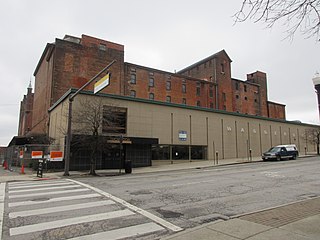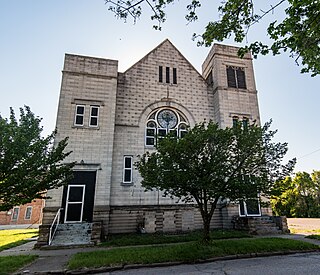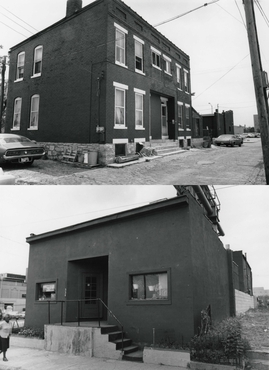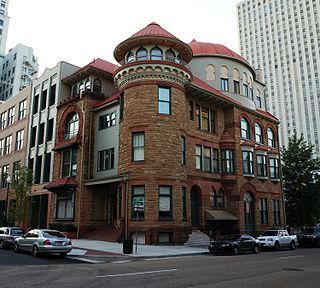
The Lantern is an independent daily newspaper in Columbus, Ohio, published by students at Ohio State University. It is one of the largest campus newspapers in the United States, reaching a circulation of 15,000.

The former Piqua High School, built in 1914, is an historic building located at 316 North College Street in Piqua, Ohio. Also known as Piqua Central High School, it was designed by Howard and Merriam in the Classical Revival style.

To Honor the Immigrants is an outdoor 1991–1992 bronze sculpture by Gary Ross, installed at Columbus, Ohio's Battelle Riverfront Park, in the United States.

The Huntington National Bank Building is a bank and office building on Capitol Square in Downtown Columbus, Ohio. Once the headquarters to the Huntington National Bank, it now includes the company's primary lending bank, the Capitol Square Branch. It is part of the Huntington Center complex, which also contains the Huntington Center skyscraper, Huntington Plaza, and DoubleTree Hotel Guest Suites Columbus.

The Ohio National Bank building is a historic structure in Downtown Columbus, Ohio. The Neoclassical building was designed by Richards, McCarty & Bulford, built in 1911, and largely remains as built. It was a long-term location for the Ohio National Bank. It was listed on the National Register of Historic Places in 1980, noted as one of the most significant examples of Greek Doric classical ornamentation in Columbus, with refined details throughout the building.

Central Market was a public market in Downtown Columbus, Ohio. The market operated from 1814 to 1966, was the location of Columbus's first city hall for two decades, from 1850 to 1872. It moved three times, each time into successively larger buildings. The third market building stood the longest time, from 1850 to 1966, when it was demolished as part of the Market-Mohawk Urban Renewal project. North Market remains, the only one left of four public markets that operated in the city.

The Great Flood of 1913 severely affected Columbus, Ohio. The area most affected was Franklinton, also known as the Bottoms, for its low elevation near the Scioto River. Among many infrastructure projects, a 7.2-mile floodwall was built from 1993 to 2004 to protect most of Franklinton from flooding.

Budd Dairy Food Hall is a food hall in the Italian Village neighborhood of Columbus, Ohio. The Cameron Mitchell Restaurants-run hall holds ten foodservice locations, three bars, and indoor, patio, and rooftop seating. It is situated in the historic Budd Dairy Company building, a former milk processing and distribution facility. The space was renovated beginning in 2018, and opened in April 2021.

The L. Hoster Brewing Company is set of historic buildings in the Brewery District of Columbus, Ohio, United States. The site was listed on the National Register of Historic Places in 2009.

The West Side Spiritualist Church was a historic church building in Franklinton, Columbus, Ohio. The Spiritualist church was built in 1912 for the congregation of Harry Boerstler, who moved to the neighborhood in 1900 to bring hope to its working-class people. The congregation lasted until about 1948, and the building later housed the Boerstler Memorial Spiritualist Temple and the Greater Christ Temple Apostolic Church. After years of vacancy, the church building was approved to be demolished for affordable housing, to accompany an upscale mixed-use development nearby, despite opposition from preservationists.

The Elijah Pierce Properties were historic buildings in Downtown Columbus, Ohio. They were listed on the National Register of Historic Places in 1983.

David Riebel was a German-American architect in Columbus, Ohio. He was the head architect for the Columbus public school district from 1893 to 1922. In 1915, The Ohio Architect, Engineer and Builder considered his firm, David Riebel & Sons, to be the oldest and among the best architects in Columbus.

The First Avenue School is a former public school building in the Harrison West neighborhood of Columbus, Ohio. It was listed on the Columbus Register of Historic Properties in 1983, and was listed as part of the Near Northside Historic District, on the National Register of Historic Places, in 1980. The building is one of the oldest in the neighborhood, built in 1874. It is also one of the oldest remaining school buildings in Columbus, built at the same time as the Second Avenue School and Stewart Alternative Elementary, also still extant. In 1984, Wood Development remodeled the building into the First Avenue Office Center at a cost of $1.2 million.

Elah Terrell (1851–1920) was an American architect from Columbus, Ohio. Terrell designed important buildings under the company Elah T. Terrell & Co. in Ohio, notably in Sheffield, Lorain County, and Columbus. Terrell was a member of the Ohio chapter of the American Institute of Architects.

The Ohio Institution for the Deaf and Dumb was a deaf school campus in Downtown Columbus, Ohio. The school, today known as the Ohio School for the Deaf, sat on the present-day Topiary Park grounds in the modern-day Discovery District. The main school building was gutted by a fire on October 2, 1981, though an existing building still stands as Cristo Rey Columbus High School. That remaining building is listed on the National Register of Historic Places and Columbus Register of Historic Properties.

The Columbus Developmental Center (CDC) is a state-supported residential school for people with developmental disabilities, located in the Hilltop neighborhood of Columbus, Ohio. The school, founded in 1857, was the third of these programs developed by a U.S. state, after Massachusetts in 1848 and New York in 1851.

The Joseph Henderson House, also known as the A.H. Dierker House, is a historic farmhouse in Columbus, Ohio. The house was built in 1859 by Joseph Henderson for him, his wife, and their ten children. The family lived on-site until the 1930s, when Arthur H. Dierker's family moved in, living there until 1983. The house was added to the Columbus Register of Historic Properties in that year. Since then, the building has been used for offices, and since 2018, a local brewery.

The Renaissance Columbus Downtown Hotel is a Renaissance Hotel in Downtown Columbus, Ohio. The hotel has 22 stories, and was designed by Columbus architects Kellam & Foley in the International style.

The Park Hotel was a hotel in Columbus, Ohio. It was later in its history known successively as the Northern Hotel, the Railway Y.M.C.A., and as the Goodale Hotel. The building stood at the northwest corner of North High Street and Goodale Street.
This is a list of historical and operating fire stations in Columbus, Ohio, part of the Columbus Division of Fire (CFD). Buildings in this list are grouped by station number and are sortable by name, date, and status.






















